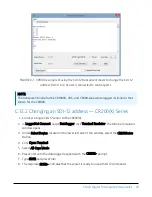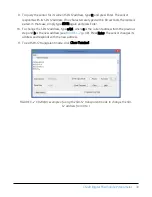
Table C-3: Example aC! sequence
X+1+2+3+4+5<CR><LF>
The sensor immediately responds with the sensor
address and the 5 values.
YD0!
Ten seconds later, after a total of 40 seconds have
passed, the data logger starts the process of
collecting data from sensor Y by issuing the first
D
command.
Y+1+2+3+4+5+6<CR><LF>
The sensor immediately responds with the sensor
address and the 6 values.
C.9 Stopping a measurement command
A measurement command (
M!
) is stopped if it detects a break signal before the measurement is
complete. A break signal is sent by the data logger before most commands.
A concurrent measurement command (
C!
) is aborted when another valid command is sent to the
sensor before the measurement time has elapsed.
C.10 Send data command (aD0! … aD9!)
The Send Data command requests data from the sensor. It is issued automatically with every type
of measurement command (
aM!
,
aMC!
,
aC!
,
aCC!
). When the measurement command is a
M!
or a
MC!
, the data logger issues the
aD0!
command once a service request has been received
from the sensor or the reported time has expired. When the data logger is issuing concurrent
commands (
aC!
or
aCC!
), the Send Data command is issued after the required time has elapsed
(no service request will be sent by the sensor). In transparent mode (
27)), the user asserts this command to obtain data.
Depending on the type of data returned and the number of values a sensor returns, the data
logger may need to issue
aD0!
up to
aD9!
to retrieve all data. A sensor may return up to 35
characters of data in response to a
D
command that follows an
M!
or
MC!
command. A sensor
may return up to 75 characters of data in response to a
D
command that follows a
C!
or
CC!
command. Data values are separated by plus or minus signs.
Command:
aD0!
(
aD1!
…
aD9!
)
Response:
a<values><CR><LF>
or
a<values><CRC><CR><LF>
where:
a
= the sensor address
CS320 Digital Thermopile Pyranometer
26






































